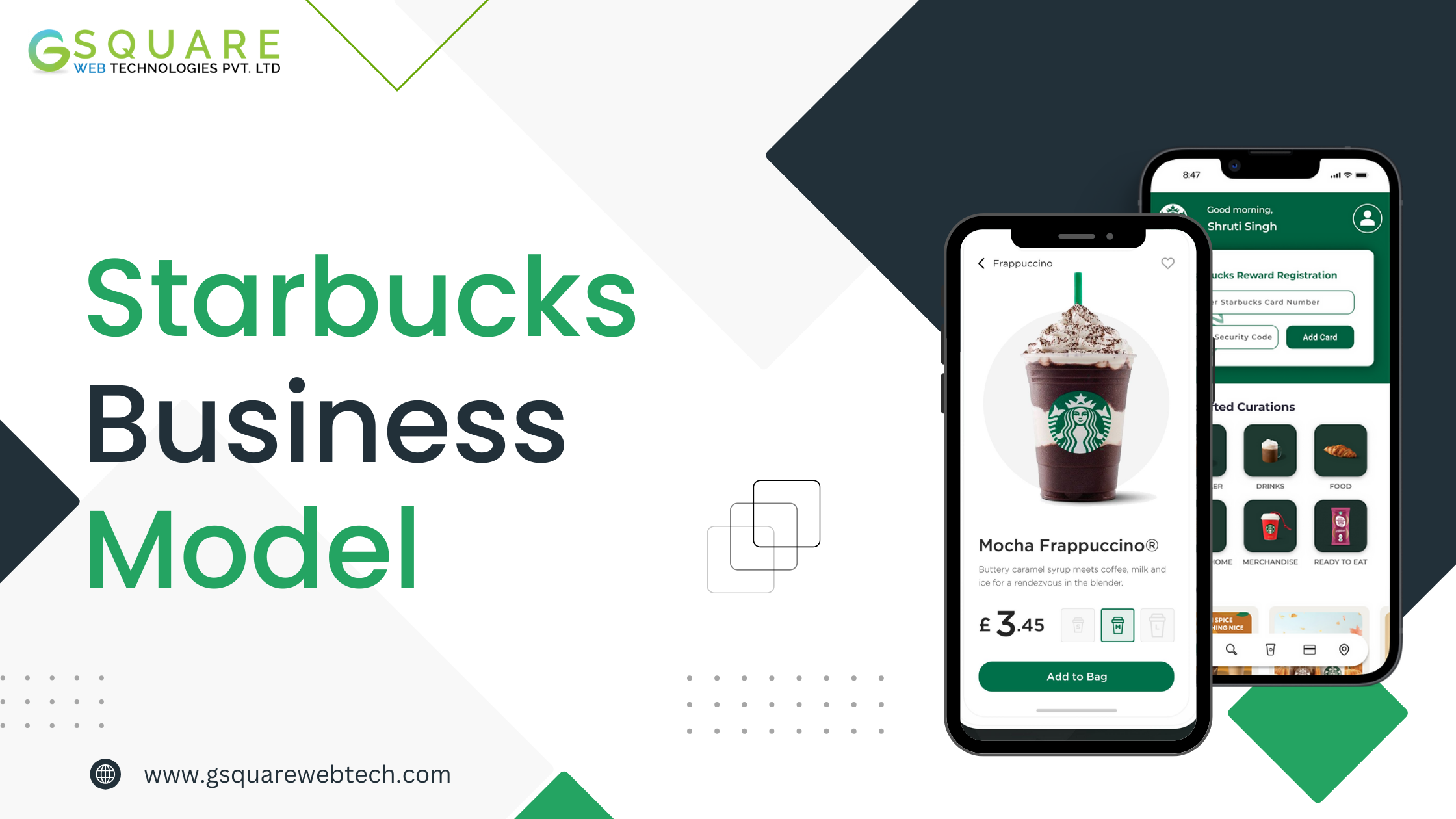
Starbucks Business Model Analysis And Summary
With 30,000 stores in over 84 countries, Starbucks is known as “the McDonald’s of coffee. Started in 1971 Starbucks not only deals in coffee but also offers teas, pastries, and other related treats. It generates an aroma of soft music and lets people experience a peaceful environment where they can chat, meet up, or even work. Starbucks calls itself a neighborhood gathering place.
This Seattle-based coffee monolith spread its coffee business along with establishing a totally new culture and became a leader of its own industry. And not only in its home country but also globally. Currently with around 40% share in the US coffee market, Starbucks is very popular in China, opens a new store every 15 hours, and targets to reduce this time to 9 hours for the next three years. In the US Starbucks is the only giant in the coffee market that covers the nationwide area whereas competitors are concentrated in the eastern and western coasts only.
Starbucks earns $26.58 billion in a year worldwide with around half the number of its stores located in the US only. It generates 3M mobile transactions per week and following McDonald’s it is the most valuable brand worldwide. Starbucks is the first company to introduce a wholly new coffee culture and, the first privately owned company to offer employees health insurance. What Starbucks achieved in the last 50 years is very hard to achieve for most of the brands and the biggest dream of potential entrepreneurs in the domain.
How Did Starbucks Start?
The history of coffee in the USA is as old as the country itself though coffee shop is a new phenomenon. It wasn’t until the late 19th and early 20th century that coffee shops became popular in the country. Coffee’s demand started to rise when the US railroad network helped it to proliferate. It made coffee accessible and affordable to more or less anyone who want to find and drink it.
It was the 1920s when coffee culture started to offer a social setting to all those who worked in US offices, however, coffee shops were still relatively uncommon until the Great Depression of 1929 came. When the Great Depression hit, food banks and soup kitchens began handing out coffee and donuts to hungry citizens. This was the time when the US’s modern obsession with coffee began known as the first wave of coffee culture across the country.
Starbucks is a product of the second wave of coffee that emerged in the late 1970s. This was the time when people started to spend a significant amount of time in coffee shops. Gradually, cafe culture started to become a social concept in the US. This wave started to gather speed in the 1980s and gave way to coffee chains, Starbucks seized the opportunity.
How And When Was Starbucks Founded?
The story of Starbucks started in the early 1970s when three friends, English teacher Jerry Baldwin, History teacher Zev Siegl, and Writer Gordon Bowkerat, met a coffee roasting entrepreneur, who taught them his style of roasting beans. They decided to start a company and find a name starting with “St” and then finally, inspired by Moby-Dick’s book, they named their startup ‘Starbucks’ this is how this coffeehouse chain was born in Seattle, Washington.
Initially, the first shop would only sell roasted whole coffee beans until 1976. Later, Howard Schultz came into contact with Starbucks and after identifying its potential decided to join the company as director of retail operations and marketing. Later on, Starbucks started providing coffee to fine restaurants and espresso bars. In 1983, when Schultz traveled to Italy & observed the espresso bars in Milan, he figured out new ways of taking this business to heights and decided to develop a similar coffeehouse culture back in Seattle.
Schultz started a coffee house chain in 1985 and after two years rebranded that with Starbucks and began expanding the company. Soon, many new stores of Starbucks opened and by the year 1989, there were 55 Starbucks stores in the United States. Happy with its success Starbucks stakeholders completed its initial public offering (IPO) on the stock market in mid-1992. At that time its revenue was $73.5 million and the market value was $271 million. It was the year, 1996 when Starbucks opened its first store outside North America in Tokyo, Japan. Today this coffee house chain giant has more than 30 thousand stores worldwide.
Business Model of Starbucks
The model that makes Starbucks a worldwide brand doesn’t have any customer segmentation. One who wants high-quality coffee is a part of Starbucks’ customer segment. However, it targets the upper-middle class because prices in most locations are a little bit higher than its competitors. In general, it focuses on the mass market.
Starbucks is known for innovative products to attract more consumers and market its brand further. It never compromises with the quality and only prefers high-quality beans and trans roasters to work on them. Along with having amazing physical stores it also takes orders via mobile app, which also helps avoid lines at the stores. To offer its customers variety Starbucks comes with 30 blends of coffee and a wide range of sandwiches. It is a powerful brand seen as a synonym of quality. These are all collectively known as Starbucks Value Preposition.
Channels that Starbucks utilizes to expand its business include Coffee shops, grocery stores, retailers, Starbucks cards, Starbucks customer service, Starbucks apps, and social media. To maintain a loyal customer base employees at Starbucks play a significant role. These employees make and serve products to the consumers and also assist them anyhow to ensure a loyal customer base for the brand.
Starbucks generates revenue through beverages (especially coffee) and food selling in both company-operated and licensed stores. It also collects royalties and earns recurring revenue from licenses and packed goods as well. To efficiently run its business worldwide Starbucks hires trained and capable human resources, and contracts with high-quality coffee farmer centers, product developers, and stores.
Key activities that Starbucks performs include continued product development, customer service, marketing, production, R&D, cleaning, and others. Starbucks is strengthening itself with partners that include suppliers worldwide, coffee producers, outside trading companies, exporters, retailers, and distributors. It primarily spends on administration, operation, marketing, and distribution.
Starbucks Competitors
Starbucks is not a lone wolf in the market, some other competitors are also doing well in the coffee house chain industry. Dunkin’ Donuts is one of them. It is a donuts and coffee house with more than 12 thousand stores in over 40 countries. Another one is Costa Coffee, known as one of the best British coffeehouse chains founded a year earlier than Starbucks in 1970. However, this coffeehouse chain was acquired by Coca-Cola in 2019. The list doesn’t end here McCafé, a subsidiary of McDonald’s and a coffee-house-style food and beverage chain also competing hard with Starbucks. Founded in Melbourne, Australia in 1993, McCafé was started by McDonald’s CEO after evaluating the trend of espresso coffees globally.
Actually, the 19th century not only gave birth to Starbucks but also some of its best competitors. That’s why Tim Horton’s – a Canadian-based fast-food multinational with popular coffee and donuts, Peet’s Coffee – specializes in coffee roasting, Lavazza – a brand of coffee in Italy, Yum China: – the largest restaurant operator in China, Café Coffee Day – India’s largest coffee chain, and Independent coffeehouses; are some of the biggest competitors at various locations across the world. Starbucks not only needs to compete with them but also has to build dominance in the areas where these competitors are well-known names.
Starbucks Strengths, Weaknesses & Threats
- Strengths: Currently, Starbucks is the most popular brand in the food and beverage industry and generates more than $26 billion in revenue annually. More than 30 thousand stores already opened and the growth is still at a relatively fast pace. To maintain the pace, an extensive global supply network has been established with coffee beans from Latin America, Africa, and Asia. Premium blends and coffees are consistently standardized in all its locations. Starbucks makes a strategy before establishing its presence at any of the new places and reinvests its profits in business development. Employees at Starbucks are the happiest ones and the coffee house chain is often listed as one of the best places to work for. Starbucks also takes measures to protect the LGBTQ+ community at the workplace by providing them with Gender-Neutral Restrooms.
- Weaknesses: Starbucks is not strong from all sides. Its prices are higher and costs consumer more than its competitors such as McDonald’s. It gives competitors a competitive edge to beat Starbucks in the market. Also, its products are not hard to replicate making its business vulnerable. It uses a general standardization model that makes it incapable of associating with the locals’ preferences. Some of its products have more recall value than the brand itself which affects the overall brand image. Even though, Starbucks has established its stores in most of the developed nations offer it a great opportunity for expansion in emerging economies while collecting revenue from established locations. If needed it can diversify its product to meet the local preferences. To target the middle class it can offer regular coffee and can start delivery service. Its huge customer base allows it to go with some coffee subscription options if needed.
- Threats: Every business regardless of its size faces threats from its competitors and Starbucks is not an exception. Many competitor coffeehouses of Starbucks offer relatively cheaper products, some of them are multinational companies such as Dunkin’ Donuts and McCafe, threatening the full-scale business of Starbucks. If want they can easily reproduce the same products as Starbucks. Also, Starbucks’ daily business operations depend on the contractors and stakeholders, which makes it hard to manage the whole supply chain. Additionally, due to the recent pandemic, Starbucks’ revenue has already dropped making it hard to invest at the same rate. Last but not least, coffee beans’ prices are rising, all threatening Starbucks to maintain its more than 50 years-long established brand.
 Summarizing
Summarizing
All in all, Starbucks may have to face its own challenges while fighting with weaknesses but no one can decline that it is the masterpiece in market domination. Started as a bean roaster in Seattle it has established its own empire. Marketing & strong online presence is something that plays a significant role in its branding and overall growth. Want to learn more about marketing nuances and increasing business presence through having a website or mobile app? Get in touch with our seasoned marketing experts and developers and learn more about business establishment and marketing techniques.





